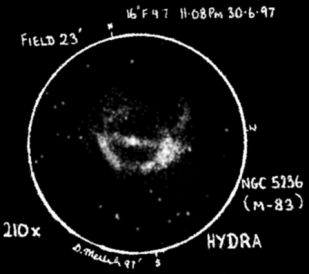 Sketch 2: Sketch 2:
This shows NGC 5236 (M 83) which is a startling contrast to the previous objects. NGC 5236 is perhaps the most beautiful example of a face-on spiral galaxy. In the 16inch at 210x this is a marvellous galaxy absorbing most of the 23' field with its soft twirling glow. A large bright core is dissected by a prominent bar which is encased in a large round halo that has a spiral arm that protrudes from the left and curves down south. To the right, protrudes another smaller spiral arm that curves outward and arcs towards the north, making the object a first-rate face-on spiral galaxy, and a superb target for large Dobsonian telescopes. Its overall size is about 16.0 x 13.0 making it a grand and handsome object worthy of observation in any size telescope.
NGC 5236, or M83 as it is otherwise known was discovered by Lacaille in 1752 and it is one of the most luminous of the 25 or so brightest galaxies in the sky, along with M31 in Andromeda and NGC 55 to name but a few. NGC 5236 lies around 10 million light years away and it has had quite a few supernovae over the years. The first was discovered in 1923 by C.O. Lampland at Lowell Observatory and numerous others have occurred since. In a large telescope this is a wonderful object that merits careful observation as its curving spiral arms are splendid. Definitely a treat for the keen galaxy observer.
|